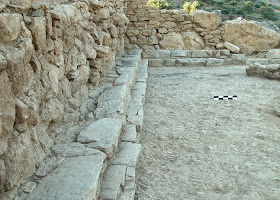 |
| Monumental Civic Building excavated at Azoria in 2006 [Credit: Azoria Project/ University of North Carolina at Chapel Hill] |
Although the site has a long history of use, the most visible remains are the houses and communal buildings of Archaic date (600-500 BC). The Archaic rebuilding expanded the settlement to its maximum size (c. 15 hectares), created a zone of communal buildings—discovered have been a communal dining building, a monumental civic building, and an Archaic shrine.
The Azoria project excavations took place between 2002 and 2006 and there was a hiatus from 2007 until 2012, when conservation work was done. Excavations resumed last year and they are scheduled to continue through 2017, followed by additional years of study.
Fieldwork is conducted by permission of the Greek Ministry of Culture under the auspices of the American School of Classical Studies at Athens and the Archaeological Service of Eastern Crete (24th Ephorate of Prehistoric and Classical Antiquities). The main supporting institutions are the Department of Classics at the University of North Carolina at Chapel Hill, the Classical Studies Program at Iowa State University, the Curriculum in Archaeology and the Research Laboratories of Archaeology at UNC, the Institute for Aegean Prehistory Study Center for East Crete (INSTAP-SCEC), and the Duke-UNC Consortium for Classical and Mediterranean Archaeology (CCMA).
No comments:
Post a Comment